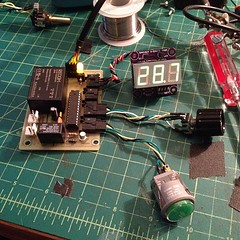New Workshop!
 We moved recently, and one of the features that drew us to our new home was a sun room in the back, maybe 8'x15', full of light and perfect for a workshop!
We moved recently, and one of the features that drew us to our new home was a sun room in the back, maybe 8'x15', full of light and perfect for a workshop!One corner is ideal for the laser, with a dryer vent for routing its (filtered) fumes outside. With two rolling racks for storage and two desks, I hope we'll have room for a small heavy bench and drill press. Good thing the Printrbot is (er, will be) small, we have big plans for this little room.
I got a kick out of reading my "Workshop!" post from two years ago, most of those projects haven't moved too much forward, but the grinder timer has gone through a few versions and the flight suit ended up being by far my most complicated project so far.




